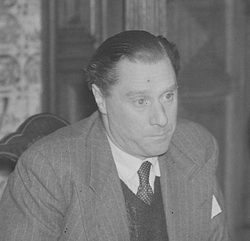| Academy Award for Best Director | |
|---|---|
 The 2025 recipient: Sean Baker | |
| Awarded for | Excellence in Cinematic Direction Achievement |
| Country | United States |
| Presented by | Academy of Motion Picture Arts and Sciences (AMPAS) |
| First award | May 16, 1929 (for films released during the 1927/1928 film season) |
| Most recent winner | Sean Baker, Anora (2024) |
| Most awards | John Ford (4) |
| Most nominations | William Wyler (12) |
| Website | oscars |
The Academy Award for Best Director (officially known as the Academy Award of Merit for Directing) is an award presented annually by the Academy of Motion Picture Arts and Sciences (AMPAS). It is given in honor of a film director who has exhibited outstanding directing while working in the film industry.
Contents
- Winners and nominees
- 1920s
- 1930s
- 1940s
- 1950s
- 1960s
- 1970s
- 1980s
- 1990s
- 2000s
- 2010s
- 2020s
- Multiple wins and nominations
- Multiple wins
- Three or more nominations
- Age superlatives
- Records
- Notes
- See also
- References
- Bibliography
- External links
The 1st Academy Awards ceremony was held in 1929 with the award being split into "Dramatic" and "Comedy" categories; Frank Borzage and Lewis Milestone won for 7th Heaven and Two Arabian Knights , respectively. [1] However, these categories were merged for all subsequent ceremonies. [2] Nominees are determined by single transferable vote within the directors branch of AMPAS; winners are selected by a plurality vote from the entire eligible voting members of the academy. [3] [4] [5]
For the first eleven years of the Academy Awards, directors were allowed to be nominated for multiple films in the same year. However, after the nomination of Michael Curtiz for two films, Angels with Dirty Faces and Four Daughters , at the 11th Academy Awards, the rules were revised so that an individual could only be nominated for one film at each ceremony. [6] That rule has since been amended, although the only director who has received multiple nominations in the same year was Steven Soderbergh for Erin Brockovich and Traffic in 2000, winning the award for the latter.
The Academy Awards for Best Director and Best Picture have been very closely linked throughout their history. Of the 91 films that won Best Picture and were also nominated for Best Director, 70 won the award. [7] [8] The award has been criticised in recent years for failing to recognise female directors. [9] Of the 257 individual directors nominated in the history of the award, only 9 have been women; [10] and only 3 of the 76 winners have been women. [11]
Since its inception, the award has been given to 74 different directors or directing teams. As of the 97th Academy Awards ceremony, American filmmaker Sean Baker is the most recent winner in this category for his work on Anora .






























































